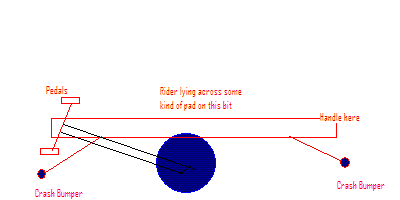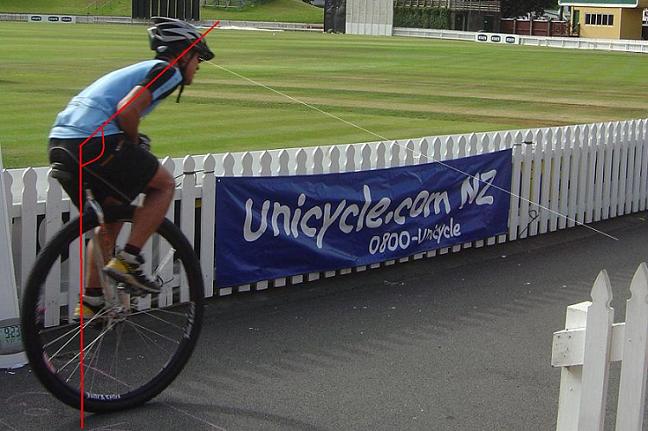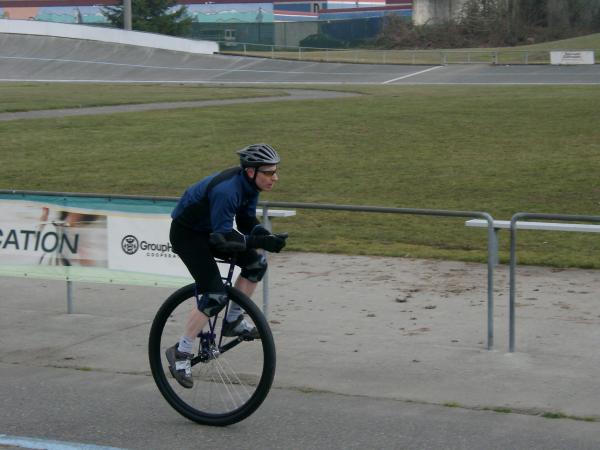i can’t answer your questions, but i just wanted to say the first thing that came to mind when i saw that was “ow that must give you a backache”
Re: Questions on fast unicycles
Neat idea, but lots of feedback so far indicating that it may not offer any real advantage. Two points to consider:
- A freewheeling crankset (pedal arms and pedals - seperate from the chain and chain rings) was the novel idea behind the Schwinn World Traveller ten speed (circa 1982?), which allowed shifting on-the-fly, and, in this application would allow grabbing the hand “pedals” and keeping them stationary while still pedaling with your feet. That would fix the flailing hands when trying to add arm effort to climb hills or increase speed. It would also allow you to get your hands and feet into a comfortable rhythum.
- Instead of trying to do this with a unicycle, it would seem more feasible on a monocycle (with the rider inside the wheel), or is that a forbidden topic?
The Tour de France and other similar UCI events are really bad examples as far as bike evolution goes though, for two reasons. First the obvious one that in order to make it a ‘pure athletic challenge’ they don’t allow funny bikes, which basically haven’t evolved much since 1934. Secondly, drafting, which means that there’s a massive advantage to having the same shape bike as everyone else, and far fewer advantages to having super streamlined bikes.
Outside the UCI, the HPV hour record is about 1.7 times as fast as the limited one, and that’s usually on a pretty wacky bike. A couple of the IHPVA world records in the late 70s were done on hand and foot cranked bikes.
One thing that’s really important in a unicycle design is to design what happens in a crash, something to protect the rider from the chainring in front of them would be nice, and to protect the chainring from hitting the ground.
I think for really good riders, forward backward balance isn’t a massive issue once they’ve got going. Because of this, I reckon a much more extreme version of this design would be possible, where the rider lies down over a relatively small wheel, with a chain drive from their feet which are behind the wheel, and either a handle or your weirdy extra cranks thing to hold onto in front of the wheel. Obviously it’d only be any good for very smooth tracks, but for a pure speed record ride it could just be worth doing. If it was very low down, it’d be simple enough to fit bumpers off the frame that slid on the ground in the case of a crash, leaving the rider’s hands or feet protected, and stopping the unicycle tipping.
Joe

This is getting closer and closer to the “fully fared recumbent egg unicycle” we were discussing in the pub at the muni weekend! Wouldn’t steering be pretty near impossible with that prone position (moments of inertia and all that)?
Rob
For combined arm and leg power these things are supposed to be pretty efficient:
http://www.rowingbike.com/main.php
I don’t think it’d translate well to unicyling but as JF says, nearly anything is ridable
It seems that not.
There’s very fiew information on their site. I watchet carefully wideos. It seems they have problems going up the hill. and it seems it is slow vehicle.
There’s some theory on rowing/ cycling comparison
http://web.kyoto-inet.or.jp/people/kazuho/manasle/manasle.htm
If using gyro stabilizer and hands only drive something like that could be done. What i like about this is that if that bike would be faired, it would be very small and probably fast.
What if hands alone can consumpt all O2 lungs can provide…
They still won’t provide as much power as the legs. That last set of drawings is fascinating…unless you’re claustrophobic. I don’t know if you left enough room for that guy to inhale… ![]()
But I don’t agree with the earlier comment that front-back balance is a “done deal” for experienced riders. Side-to-side balance is only an issue for beginner riders. Once you’re moving, it’s easy to deal with. But front-to-back is always what you have to maintain, and it gets harders once you gear up the wheel. I learned this very powerfully when I rode Roger Davies’ Schlumpf Coker in the Marathon at Unicon. It took a very high level of concentration to stay up on it, which made me slower than I otherwise could have been. And I’m a very experienced rider. More practice will make me better I’m sure, but front-back balance will be more of an issue, not less, as you spread the body away from the vertical.
I have some low handles out front on my own Coker, which put me into a semi-aero position. My worry is that the further down I go, the less stable I feel in front-back balancing. Also, the more vulnerable I am in a crash, because my body position is poorly suited to running out of a forward dismount. I’ll already be in that last stumbling position you reach before falling forward, head-first.
But, if the goal is speed, the position must be aero. It will probably be a risk riders have to take to break unlimited speed records. Also if your goal is for it to be effective, rather than just experiments in different odd designs, don’t worry about hand-cranking. I’d start with Ken Looie’s 30-degree back angle, a geared wheel, and work from there. Ultimately with a design that allows the handlebars to be adjusted for various body positions.
I find it more stable to be in a low-down position at speed- you lower your centre of gravity and are therefore less likely to get thrown off if you hit a bump. And it’s probably more aero too ![]()
Ok…maybe not quite 30 degrees, but you get the idea…

Ken, I think you and Pete have two of the more forward riding styles I’ve seen. I’d like to evolve mine more that direction, but I’m still pretty much a straight up guy.
Mozq, the unicycle in the pic below is probably one of the “fastest potential” speed machines out there today. Pete can correct me if I get it wrong, but I think the gearing ratio on this was 1:1.87, or a 67 inch wheel. I’m not sure how fast Pete has had it going, but put it in the hands of one of the expert young’uns with no kids or sense of self preservation, and it could certainly set a new unicycle “land speed record”.
Your design looks cool, but I question the value-add of the hand cranks. Excess hand movement on a unicycle–unless directed specifically at maintaining balance–would be de-stabilizing IMHO. At least for the majority of riders.

The combined foot pedal and hand crank idea is interesting. Would be fun to ride a prototype just to see what it’s like to ride a unicycle like that. More of a novelty I would suspect, but you never know till you try. Who knows, maybe getting the arms involved could add to the stability? Maybe setting up the hand cranks to be 1/4 revolution out of phase with the pedals will smooth out the dead spot in the pedal stroke and help keep the speed up and consistent?
You could have the hands pedal at half the cadence of the feet. That would make it easier for the hands to keep up. With the jackshaft gearing of Pete’s unicycle design you could gear it such that the feet are going at about 100 RPM at the designed for speed, and the hands would be going at 50 RPM. That sounds reasonable.
Traditionally for a standard unicycle you get into some crazy high cadences to go fast. A cruising cadence over 150 and up near 200 (or faster) when putting the speed on. At those cadences you’re not so much controlling the unicycle as just going along for the ride. Slower cadences allow for more control. Gearing a speed record unicycle for a cadence of about 100 at the designed for speed would probably be more efficient.
Regarding the “centaur (combi drive)” – where can I read more about it? I tried to search the web but didn’t find anything. Thanks!
There’s something funny about that bike. It appears to have triple chainrings both front and rear, but no sign of any derailleurs. Probably an experimental machine. But looks like the rider, in this version, has to pedal at the same speed with hands and feet both. And it’s a fixed gear. If you make both parts shiftable it would be different. You would have to stop pedaling to shift though, which could be a little messy for a derailleur-type system.
And the two separate drive trains add weight.
My thinking is that this is a fun thought experiment, but that if adding hand-pedaling to a bike would make it faster, we would see people out there doing it and bikes made for it. We don’t.
He has also mounted the front forks backwards so that the hub is behind the line of the steering tube.
It’ll never catch on.